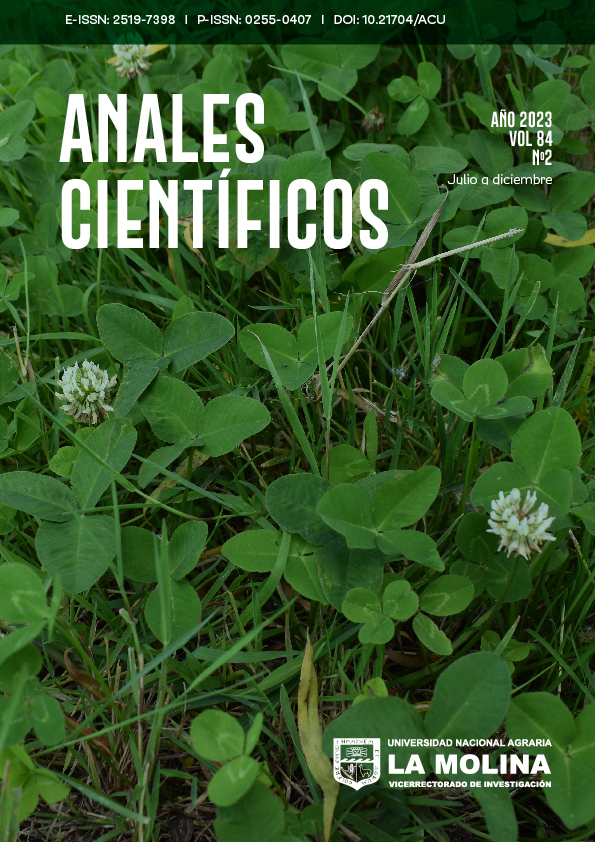Prices and opportunity cost of commercial agriculture in Peru 2001-2021
DOI:
https://doi.org/10.21704/ac.v84i2.921Keywords:
commercial agriculture, opportunity cost, agricultural financial riskAbstract
In Peru, exports of agricultural origin have multiplied almost 10 times, going from an FOB value close to US$200 million in 2001, to a value of US$1,950 million in 2022; however, the participation of its negotiable securities (company shares) in a centralized market on the Lima Stock Exchange (BVL) is very low. With the exception of sugar companies, most don’t report information on the market prices of their corporate shares on the BVL, which limits the calculation of the opportunity cost of capital (COK) in this sector. The objective of the investigation was to approximate the agricultural COK from the prices registered by the exported and imported products, considering a sample made up of seven export products and six import products, which represent more than 85% of the value of agricultural commercialization. from Peru abroad. To determine the agricultural COK, the Capital Asset Pricing Model (CAPM) model was used, a capital asset valuation model that allows calculating the price and behavior of variable financial assets. The research achieved the objective of determining the COK for the commercial agricultural sector in Peru for the period analyzed 2001 - 2021, the resulting value reached the level of 20.24%, which reflects assuming the investment risk in this sector and that is below the calculations made by other studies and below the high discount rates that commercial banks apply to the flow of investment projects in agriculture, punishing the value of investments in the sector much more.
Downloads
References
Banco Central de Reserva del Perú. (2022). Series Estadísticas BCRP, consultas continuas en su portal web institucional, https://www.bcrp.gob.pe/estadisticas.html
Bolsa de Valores de Lima. (2022). Series estadísticas financieras de empresas peruanas, consultas continuas en su portal web institucional, https://www.bvl.com.pe/ emisores/listado-emisores
Bravo, S. (2008). Teoría Financiera y Costo de Capital. Instituto de Regulación y Finanzas, Universidad ESAN, Lima, Perú. www.fri.com.pe
Damodaran. (2022). Tasas porcentual de rendimiento anual tasa libre de riesgo, tasa de rendimiento de mercado y riesgo país. https://pages.stern.nyu.edu/~adamodar/
Food and Agriculture Organization, FAO. (2023). Situación alimentaria mundial, índice de precios de los alimentos de la FAO, Series estadísticas financieras de empresas peruanas, consultas continuas en su portal web institucional. www.fao.org/worldfoodsituationfoodpricesindex/es/
Fernández, J. (2008). Internalización del riesgo en la determinación de la tasa de costo de capital. España: Universidad de Rioja, España.
Magallanes, J. (2021). Costo de Oportunidad del sector agrícola Comercial Exportador en el Perú, 1998-2017. Revista Anales Científicos, 82 (1). Universidad Nacional Agraria La Molina, Lima, Perú.
Markowitz, H. (1952). Teoría de la Cartera de Markowitz. The journal of finance, 7 (1). American Finance Association. Recuperado de https://www.math.ust.hk/~maykwok/ courses/ma362/07F/markowitz_JF.pdf
Martinez, C. (2014). Modelo de Cálculo de las Betas a aplicar en el Capital Asset Pricing Model. El caso de Argentina. Rev. Estudios Gerenciales estud.gerenc., 30 (131) Cali Apr. / June 2014.
Mascareñas, J. (2010). Determinación de una tasa de descuento sector empresarial. España: Editorial Universidad Complutense de Madrid.
Mejía Robles, L. (2010). Estimación de Costo de Capital Empresas Públicas. Ministerio de Educación, Ciencia y Cultura, Colombia.
Reyes-Clavijo, M. (2023). Modelo de Valoración de Activos Financieros (CAPM) aplicado al sector empresarial de Ecuador, Revista de Ciencia de Administración y Economía, Universidad del Azuay, Cuenca, Ecuador, https://doi.org/10.17163/ret.n25.2023.08
Sarmiento, A. (2008). Análisis de costos de la generación de energía eléctrica mediante fuentes renovable en el sistema eléctrico colombiano. Colombia: Universidad Militar Nueva Granada.
Spicka, J., Derenik, P. (2021). How opportunity costs change the view on the viability of farms? Empirical evidence from the EU. Agricultural Economics – Czech, 67, 2021 (2): 41–50. https://doi.org/10.17221/412/2020-AGRICECON
Superintendencia de Mercado de Valores SMV. (2022). Series estadísticas financieras de empresas peruanas, consultas continuas en su portal web institucional, https://www.smv.gob.pe/SIMV/Frm_InformacionFinanciera?data.
Valderrama, M. (2011). Aproximación a las metodologías de estimación del costo de capital en los proyectos de inversión. El caso colombiano. AD-MINISTER, Medellín, COLOMBIA.
Valenzuela, A. (2012). Costo de Capital, modelo CAPM. Chile: Libro texto, Facultad de Ciencias Sociales y Económicas, Universidad Católica de Maule, Maule.
Vélez-Pareja, I. (2011). Estimación de betas y relación entre las betas apalancadas y el coste del capital.Análisis Financiero, 116, 6-13. Instituto Superior de Analistas Financieros, España.
Vélez-Pareja, I. (2003). Cost of Capital for Non-Traded Firms (Costo de Capital Para Firmas no Transadas en Bolsa). Academia, Revista Latinoamericana de Administración, 29, 45-75. Segundo semestre 2002, Available at SSRN: https://ssrn.com/ abstract=391620
Downloads
Published
Issue
Section
License
Copyright (c) 2023 Juan F. Magallanes Díaz, Carlos F. Camasi Montes, Juan C. Rojas Cubas

This work is licensed under a Creative Commons Attribution 4.0 International License.






